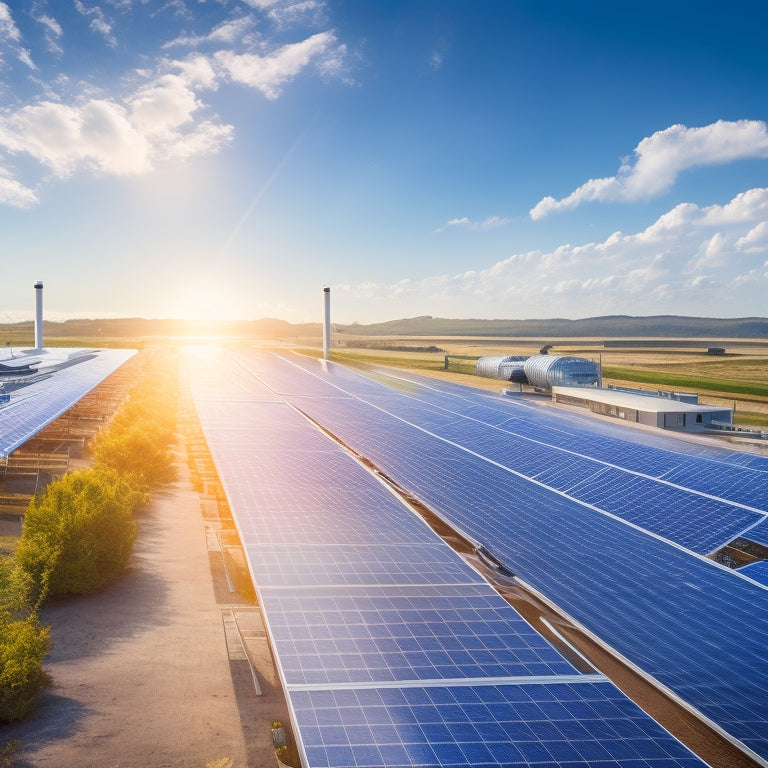
10 Ways Solar Energy Can Power Factory Efficiency
Share
You can boost your factory's efficiency by harnessing the power of solar energy. Here are 10 ways to do so: reduce energy consumption costs, increase power generation capacity, lower carbon footprint emissions, enhance operational efficiency, reduce reliance on grid energy, meet sustainability goals faster, support peak hour energy demands, extend equipment lifespan, comply with environmental regulations, and optimize production schedules. By integrating solar energy, you can reduce energy costs by up to 30% and minimize your environmental footprint. Take the first step towards a more efficient and sustainable future - and discover the full range of benefits that await you.
Key Takeaways
• Solar energy reduces energy consumption costs and enhances factory efficiency by decreasing reliance on grid energy.
• Optimizing solar panel array configuration and regular energy audits increase power generation capacity and reduce carbon footprint.
• Integrating solar energy into factory operations streamlines manufacturing processes, reduces downtime, and increases overall productivity.
• Solar power supports peak hour energy demands, manages energy load efficiently, and provides reliable backup power through energy storage.
• Adopting solar energy enhances a factory's reputation as a responsible corporate citizen, contributing to climate neutrality and reducing environmental impact.
Reducing Energy Consumption Costs
By adopting solar energy, factories can greatly decrease their energy consumption costs, as the free and abundant sunlight can power machinery and lighting systems, thereby reducing reliance on expensive and volatile fossil fuels.
You can conduct an energy audit to identify areas of inefficiency and opportunities for improvement. A thorough cost analysis will help you determine the financial benefits of switching to solar power.
By investing in solar energy, you'll reduce your energy bills and enjoy a significant return on investment. With solar power, you'll have better control over your energy expenses, allowing you to allocate resources more efficiently.
This shift towards renewable energy won't only reduce your environmental footprint but also contribute to a more sustainable future.
Increasing Power Generation Capacity
As you explore ways to increase power generation capacity, you'll find that boosting energy output is key to maximizing your factory's solar energy potential.
By optimizing panel angles and maximizing roof space, you can greatly enhance your energy generation capabilities.
Boost Energy Output
You can greatly enhance your factory's energy output by optimizing your solar panel array's configuration, angle, and cleaning schedule to maximize energy generation. Conducting regular energy audits helps identify areas for improvement, while tracking performance metrics guarantees you're meeting your energy goals.
Optimize Panel Angles
Regularly adjusting your solar panels to the best angle can greatly increase power generation capacity, as even slight deviations from the perfect angle can result in substantial energy losses.
By optimizing panel angles, you can maximize angular efficiency and reduce energy waste. This is especially important during seasonal changes, when the sun's position alters.
Implementing a regular panel maintenance schedule guarantees that your system operates at peak performance.
Adjusting your panels' angles during seasonal changes can increase energy output by up to 10%. Don't let suboptimal angles hinder your factory's energy efficiency.
Take control of your solar energy system's performance by optimizing panel angles and maximizing energy generation.
Maximize Roof Space
By strategically positioning solar panels to maximize roof space, you can greatly enhance power generation capacity and harness more energy for your factory's operations. By optimizing your roof's surface area, you can increase power output and reduce your reliance on non-renewable energy sources.
Consider roof leasing options to monetize underutilized roof space, creating a new revenue stream for your factory. Additionally, prioritize solar aesthetics to guarantee a visually appealing installation that complements your factory's architecture. By doing so, you'll not only boost energy production but also enhance your facility's overall appearance.
Lowering Carbon Footprint Emissions
Introducing solar energy systems in factories can greatly decrease greenhouse gas emissions, aiding in reducing the industrial sector's considerable carbon footprint.
You can make a substantial contribution to Climate Neutrality by adopting a Green Initiative that prioritizes sustainable energy sources. By harnessing solar power, you'll decrease your reliance on fossil fuels, minimizing the environmental impact of your operations.
This proactive approach won't only benefit the environment but also enhance your brand's reputation as a responsible corporate citizen.
As you work towards a more sustainable future, solar energy can play an important role in reducing your carbon footprint, paving the way for a cleaner, greener tomorrow.
Enhancing Factory Operational Efficiency
As you explore ways to enhance operational efficiency in your factory, you'll find that harnessing solar energy can play a significant role.
By reducing energy consumption, optimizing production schedules, and streamlining manufacturing processes, you can create a more efficient and productive work environment.
Reduce Energy Consumption
Regularly monitoring and optimizing energy usage patterns helps you identify opportunities to reduce energy consumption, an essential step in enhancing factory operational efficiency. Conducting energy audits and implementing energy monitoring systems enable you to pinpoint areas of inefficiency and take corrective action.
By analyzing energy usage data, you can identify opportunities to optimize energy-intensive processes, replace inefficient equipment, and adjust production schedules to minimize energy waste. This data-driven approach empowers you to make informed decisions, reducing energy consumption and costs.
With energy monitoring, you can track your progress, identify areas for improvement, and continually optimize your energy usage, leading to increased efficiency and reduced energy expenditure.
Optimize Production Schedules
By analyzing your energy usage patterns, you can identify opportunities to optimize your production schedules, aligning them with periods of low energy demand to minimize peak-hour energy consumption. This allows you to adjust your production workflow to reduce energy usage during peak hours, resulting in cost savings and increased efficiency.
Consider integrating your supply chain logistics to guarantee a seamless workflow, taking into account your factory layout and shift management strategies. Effective workforce planning can also help you optimize your production schedules, making sure you have the right personnel in place to meet demand.
Streamline Manufacturing Processes
You can greatly enhance factory operational efficiency by streamlining your manufacturing processes, identifying and eliminating unnecessary steps, and implementing more efficient workflows. By doing so, you can reduce production downtime, lower energy consumption, and increase overall productivity.
Here are three key strategies to help you achieve this:
-
Implement Process Automation: Automate repetitive tasks and workflows to minimize human error and increase efficiency.
-
Optimize Supply Chain Management: Streamline your supply chain by implementing just-in-time inventory management and reducing transportation costs.
-
Analyze and Refine Production Workflows: Continuously monitor and refine your production workflows to eliminate bottlenecks and increase throughput.
Reducing Reliance on Grid Energy
Your factory's reliance on grid energy can be greatly reduced by integrating solar power into your energy mix. By harnessing the power of the sun, you can decrease your dependence on the grid and enhance your factory's grid resilience.
This not only reduces your energy costs but also increases your energy autonomy. With solar power, you can generate electricity on-site, reducing your reliance on the grid and minimizing the impact of grid outages. By doing so, you'll have more control over your energy supply, ensuring that your operations remain uninterrupted.
Improving Energy Independence Status
Solar power integration enables factories to take a notable step towards energy independence, where on-site electricity generation reduces reliance on external energy sources and enhances overall energy autonomy. By harnessing solar energy, you can improve your factory's energy independence status, reducing your reliance on the grid and enhancing your energy self-sufficiency.
Here are three key benefits:
-
Reduced energy costs: Solar power can considerably reduce your energy expenses, freeing up resources for other areas of your business.
-
Enhanced energy security: With on-site energy generation, you're less vulnerable to grid outages and price fluctuations.
-
Community empowerment: By reducing your reliance on the grid, you're contributing to a more decentralized energy system, empowering your community and promoting energy independence.
Meeting Sustainability Goals Faster
By leveraging solar energy, factories can accelerate their progress towards meeting sustainability goals, reducing their ecological footprint and mitigating climate change.
As you integrate solar power into your operations, you'll be better positioned to achieve your green initiatives. This, in turn, can lead to enhanced stakeholder engagement, as investors, customers, and regulators take notice of your commitment to environmental responsibility.
By reducing your reliance on fossil fuels, you'll not only minimize your carbon emissions but also demonstrate a proactive approach to sustainability.
With solar energy, you can fast-track your sustainability goals, enhancing your reputation and contributing to a cleaner, healthier environment for future generations.
Supporting Peak Hour Energy Demands
During peak hour energy demands, your factory's energy consumption often spikes, and solar energy can help bridge the gap between supply and demand, ensuring uninterrupted production and minimizing the risk of costly downtime.
By integrating solar energy into your power mix, you can reduce your reliance on the grid during peak hours, thereby reducing your energy costs.
Here are three ways solar energy can support your peak hour energy demands:
-
Peak Shaving: Solar energy can help reduce your peak energy consumption, reducing strain on the grid and lowering your energy bills.
-
Load Management: Solar energy can help manage your energy load, ensuring that your equipment operates within a stable and efficient range.
-
Energy Storage: Solar energy can be stored for later use, providing a reliable backup power source during peak hours.
Extending Equipment Lifespan Expectancy
You can greatly prolong the lifespan of your factory's equipment by optimizing their operating conditions, which can be achieved through the integration of solar energy into your power mix. By doing so, you can reduce wear and tear on your equipment, minimizing the need for frequent repairs and replacements. This can be further augmented through predictive maintenance, asset optimization, and equipment refurbishment strategies.
| Strategy | Benefits | Implementation |
|---|---|---|
| Predictive Maintenance | Reduces downtime, increases productivity | Utilize wearable sensors for condition monitoring |
| Component Replacement | Minimizes equipment failure, reduces costs | Implement failure analysis for quality inspection |
| Equipment Refurbishment | Extends equipment lifespan, reduces waste | Conduct regular quality inspections for peak performance |
Complying With Environmental Regulations
As you explore ways to power your factory efficiently, you'll need to guarantee that your operations comply with environmental regulations.
By integrating solar energy into your factory's power mix, you can greatly reduce your carbon footprint and meet emission standards.
Reduce Carbon Footprint
By integrating solar energy into their operations, manufacturers can greatly reduce their carbon footprint, thereby ensuring compliance with increasingly stringent environmental regulations. This shift towards clean technologies and green initiatives not only helps the environment but also enhances your company's reputation.
Here are three ways solar energy can reduce your carbon footprint:
-
Renewable energy source: Solar energy is a cleaner alternative to fossil fuels, reducing greenhouse gas emissions and air pollution.
-
Energy independence: With on-site solar power, you're less reliant on the grid, reducing your carbon footprint and energy costs.
-
Long-term sustainability: Solar energy is a long-term solution, providing a stable and sustainable source of power for your factory.
Meet Emission Standards
Adhering to environmental regulations is crucial for manufacturers, and integrating solar energy into their operations helps meet emission standards by reducing reliance on fossil fuels and lowering greenhouse gas emissions. By doing so, you'll enhance air quality and maintain regulatory compliance.
Solar energy reduces the amount of pollutants released into the atmosphere, contributing to a cleaner environment. As a manufacturer, you'll be able to uphold a high level of air quality, ensuring a healthier environment for your employees and the surrounding community.
Additionally, solar energy helps you comply with environmental regulations, avoiding potential legal issues. By switching to solar energy, you'll guarantee your factory operates efficiently while minimizing its environmental impact.
Avoid Fines Penalties
You can avoid fines and penalties by complying with environmental regulations, which is where solar energy integration proves invaluable, as it helps you meet emission standards and reduces the risk of non-compliance. By investing in solar energy, you can develop effective compliance strategies that guarantee your factory operates within regulatory bounds. Stay ahead of regulatory updates and maintain a clean record with the authorities.
Here are three key benefits of solar energy integration for compliance:
-
Reduced emissions: Solar energy helps minimize your factory's carbon footprint, reducing the risk of non-compliance with emission standards.
-
Improved reporting: Accurate tracking and reporting of your energy consumption and emissions become easier with solar energy integration.
-
Proactive compliance: By integrating solar energy, you can proactively address potential compliance issues, avoiding fines and penalties.
Frequently Asked Questions
Can Solar Energy Power Entire Factory Operations During Nighttime?
You can power entire factory operations during nighttime using solar energy by leveraging battery storage systems that store excess energy generated during the day, ensuring a seamless and efficient nighttime operation.
How Do Solar Panels Impact Factory Roof Structural Integrity?
When installing solar panels, you'll need to assess your factory roof's structural integrity; a thorough structural analysis will determine if roof reinforcement is necessary to support the added weight and wind resistance.
Are Solar Energy Systems Compatible With Existing Factory Infrastructure?
As you ponder the feasibility of solar energy, consider this: are solar energy systems compatible with your existing factory infrastructure? Conducting energy audits guarantees seamless system integration, ensuring a harmonious marriage of old and new.
Can Solar Energy Be Used to Power Specific Factory Machinery?
You can optimize machine performance by allocating solar energy to specific factory machinery, ensuring efficient energy distribution and minimizing waste, thereby streamlining your operations and reducing energy costs through strategic Machine Optimization and Energy Allocation.
Do Solar Panels Require Frequent Cleaning for Optimal Performance?
You'll find that regular cleaning of solar panels is essential, as dust accumulation reduces energy output; however, you can conserve water by using dry cleaning methods or water-efficient cleaning solutions, optimizing performance while minimizing waste.
Related Posts
-

Solar System Installation Rebates and Tax Credits
Solar system installations offer beneficial rebates and tax credits that greatly cut your initial costs. You can bene...
-

Integrating Smart Technology for Energy Savings
Integrating smart technology into your home is a transformative factor for energy savings. Smart thermostats give you...
-

Solar Inverter Troubleshooting for Beginners
Troubleshooting your solar inverter starts with understanding its efficiency and performance metrics. Check for prope...


